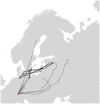Flexibility of continental navigation and migration in European mallards
- PMID: 24023629
- PMCID: PMC3758317
- DOI: 10.1371/journal.pone.0072629
Flexibility of continental navigation and migration in European mallards
Abstract
The ontogeny of continent-wide navigation mechanisms of the individual organism, despite being crucial for the understanding of animal movement and migration, is still poorly understood. Several previous studies, mainly conducted on passerines, indicate that inexperienced, juvenile birds may not generally correct for displacement during fall migration. Waterbirds such as the mallard (Anas platyrhynchos, Linnaeus 1758) are more flexible in their migration behavior than most migratory songbirds, but previous experiments with waterbirds have not yet allowed clear conclusions about their navigation abilities. Here we tested whether immature mallard ducks correct for latitudinal displacement during fall migration within Europe. During two consecutive fall migration periods, we caught immature females on a stopover site in southeast Sweden, and translocated a group of them ca. 1,000 km to southern Germany. We followed the movements of the ducks via satellite GPS-tracking and observed their migration decisions during the fall and consecutive spring migration. The control animals released in Ottenby behaved as expected from banding recoveries: they continued migration during the winter and in spring returned to the population's breeding grounds in the Baltics and Northwest Russia. Contrary to the control animals, the translocated mallards did not continue migration and stayed at Lake Constance. In spring, three types of movement tactics could be observed: 61.5% of the ducks (16 of 26) stayed around Lake Constance, 27% (7 of 26) migrated in a northerly direction towards Sweden and 11.5% of the individuals (3 of 26) headed east for ca. 1,000 km and then north. We suggest that young female mallards flexibly adjust their migration tactics and develop a navigational map that allows them to return to their natal breeding area.
Conflict of interest statement
Figures




Similar articles
-
Spring migration routes of mallards (Anas platyrhynchos) that winter in Japan, determined from satellite telemetry.Zoolog Sci. 2008 Sep;25(9):875-81. doi: 10.2108/zsj.25.875. Zoolog Sci. 2008. PMID: 19267595
-
Disease dynamics and bird migration--linking mallards Anas platyrhynchos and subtype diversity of the influenza A virus in time and space.PLoS One. 2012;7(4):e35679. doi: 10.1371/journal.pone.0035679. Epub 2012 Apr 20. PLoS One. 2012. PMID: 22536424 Free PMC article.
-
Movements, home-range size and habitat selection of mallards during autumn migration.PLoS One. 2014 Jun 27;9(6):e100764. doi: 10.1371/journal.pone.0100764. eCollection 2014. PLoS One. 2014. PMID: 24971887 Free PMC article.
-
Mallards (Anas platyrhynchos) and wastewater ponds, Part I: Mallard ducks overwintering at a northern wastewater treatment pond.Ecotoxicol Environ Saf. 2017 Sep;143:330-335. doi: 10.1016/j.ecoenv.2016.10.038. Epub 2016 Nov 8. Ecotoxicol Environ Saf. 2017. PMID: 27836493
-
Phylogenetic and lipid metabolic differences between migratory and Egyptian-domesticated Mallard ducks (Anas platyrhynchos).Comp Biochem Physiol A Mol Integr Physiol. 2025 Apr;302:111814. doi: 10.1016/j.cbpa.2025.111814. Epub 2025 Jan 19. Comp Biochem Physiol A Mol Integr Physiol. 2025. PMID: 39837383
Cited by
-
Wild Duck (Anas platyrhynchos) as a Source of Antibiotic-Resistant Salmonella enterica subsp. diarizonae O58-The First Report in Poland.Antibiotics (Basel). 2022 Apr 15;11(4):530. doi: 10.3390/antibiotics11040530. Antibiotics (Basel). 2022. PMID: 35453281 Free PMC article.
-
Synchrony of Bird Migration with Global Dispersal of Avian Influenza Reveals Exposed Bird Orders.Nat Commun. 2024 Feb 6;15(1):1126. doi: 10.1038/s41467-024-45462-1. Nat Commun. 2024. PMID: 38321046 Free PMC article.
-
Monitoring of Avian Influenza Viruses and Paramyxoviruses in Ponds of Moscow and the Moscow Region.Viruses. 2022 Nov 24;14(12):2624. doi: 10.3390/v14122624. Viruses. 2022. PMID: 36560628 Free PMC article.
-
The Impact of a Six-Year Climate Anomaly on the "Spanish Flu" Pandemic and WWI.Geohealth. 2020 Sep 1;4(9):e2020GH000277. doi: 10.1029/2020GH000277. eCollection 2020 Sep. Geohealth. 2020. PMID: 33005839 Free PMC article.
-
Consistent habitat preference underpins the geographically divergent autumn migration of individual Mongolian common shelducks.Curr Zool. 2020 Aug;66(4):355-362. doi: 10.1093/cz/zoz056. Epub 2019 Nov 13. Curr Zool. 2020. PMID: 32617084 Free PMC article.
References
-
- Walther GR, Post E, Convey P, Menzel A, Parmesan C, et al. (2002) Ecological responses to recent climate change. Nature 416: 389–395. - PubMed
-
- Berthold P, Helbig AJ, Mohr G, Querner U (1992) Rapid microevolution of migratory behaviour in a wild bird species. Nature 360: 668–670.
-
- Berthold P (2001) Bird migration, 2nd edition. Oxford: Oxford University Press.
Publication types
MeSH terms
LinkOut - more resources
Full Text Sources
Other Literature Sources

